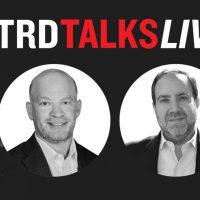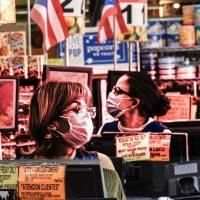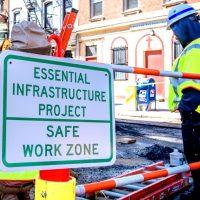Construction and manufacturing are first in line to reopen in New York, Gov. Andrew Cuomo said Sunday. But the retail and hospitality industries are looking at a longer wait, the governor said.
It’s too soon to pencil in a date for any industry, Cuomo said, but the metrics he is using to gauge the impact of the coronavirus are all trending in the right direction.
“Start incrementally, which is what everybody says — construction and manufacturing,” the governor said at his daily press conference. “The piece you wouldn’t have, and the business owners who are feeling pain — retail stores, hospitality, hotels, etc. — that is a more problematic area to open up.”
Read more



Non-essential businesses statewide have been closed for more than a month under an executive order that the governor recently extended through May 15. But his comments Sunday ignored that hotels have been exempt from that order from the outset, and are being used to house healthcare workers and the homeless. Many closed anyway because they had few customers. Among those still open in New York City, the occupancy rate is about 33 percent, and hotels may not host gatherings such as weddings and conferences.
Andrew Rigie, executive director of the NYC Hospitality Alliance, said rebooting his industry is crucial but must not be rushed. “The hospitality industry will work with Gov. Cuomo and all levels of the government to ensure that when it’s appropriate to reopen, it’s done safely and with supportive policies in place,” he said in a statement. “The hospitality industry needs to be at the core of any overall economic recovery and any return to some sense of a new normal.”
A number of retail establishments, such as supermarkets and hardware stores, have also been allowed to remain open, during which time the state has been able to reduce hospitalizations and fatalities from Covid-19.
But Cuomo took a dim view of permitting non-essential retailers to open any time soon.
“Even in some of the states that are rushing to open, you see those retail stores, they are still trying to figure out how to do that,” he said, referring to social-distancing guidelines that call for people to remain at least six feet apart. “Some let people in, some don’t let them in. So that is a complex sector to deal with. The hospitality and hotels, you know, it’s hard to do these proportions in a hotel setting.”
Hospitality includes restaurants and bars, which were shut down to dining and drinking in mid-March, a week before the governor’s more sweeping workplace closures. Only takeout service is allowed.
To reopen, manufacturers would have to show they can operate safely by spacing people out and providing them with protective gear, the governor said. The same would be true for construction, although the state is already permitting several types of construction to continue — notably schools, health-care facilities and any residential project where at least 20 percent of the units are affordable.
Discussions are ongoing between the construction industry and the Cuomo administration about protocols to allow more kinds of projects to resume.
The governor said the importance and risk factors of businesses would be weighed in determining when they can open workplaces again, and that employers in sparsely populated areas would get the green light first — even as he acknowledged the rate of transmission of the coronavirus is now higher upstate than it is downstate. In both ends of the state, though, it is under 1.0, meaning each Covid-positive person infects less than one other person. That rate would have to be maintained to allow reopening to proceed, he said.
After each phase of reopening in a region, the state would pause for two weeks to view the effects on hospitalization and infection rates. Each reopening would have to be preceded by a 14-day decline in hospitalizations.
Dr. James Phillips, an emergency-room physician and assistant professor at George Washington University Hospital, said on CNN Sunday that Cuomo’s plan is “pretty sound.”
“He’s establishing some guidelines, sort of in line with what the CDC previously released,” Phillips said. “With a complete and total lack of a federal plan for how businesses should reopen and how testing should take place, what he’s doing is very necessary. I think testing is still key here.”
Cuomo has also begun antibody testing to identify New Yorkers who have fought off the coronavirus and said that would be part of his strategy to restart the economy. That made less sense to Dr. Phillips.
“Just because your antibody test is positive, doesn’t mean you’re necessarily immune,” he said. Experts have also not settled on an antibody test that they consider to be the most effective and reliable.
New York and six neighboring states have formed a 21-member working group to develop a coordinated reopening strategy. Cuomo organized the regional effort and refers to it occasionally in his briefings but went ahead and sketched out a phased plan for New York on his own.
Referring to the coronavirus pandemic, which killed 367 New Yorkers yesterday, down from a peak of 799 and the fewest since March 31, the governor said, “There’s no doubt that we have gone through the worst, and as long as we act prudently going forward, the worst should be over.”
